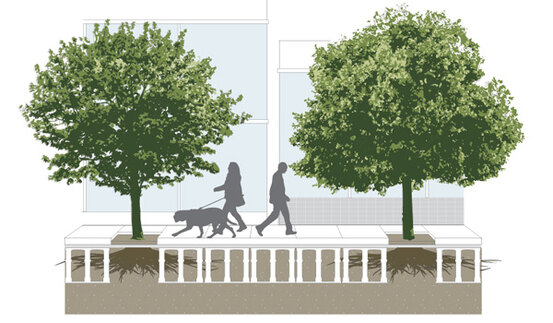
Tracking the Performance of Urban Trees in Silva Cells
by Leda Marritz, DeepRoot Green Infrastructure
Green utilities like soil, trees and water can provide a high level of ecosystem services while creating a more livable built environment. But designing spaces that satisfy the needs of both natural and built systems can be a challenge in urban areas. The abundance of paved surfaces often leaves urban trees with limited access to soil and poor soil quality that stunts growth. DeepRoot developed the Silva Cell, a modular suspended pavement system for containing unlimited amounts of healthy soil beneath paving while supporting traffic loads and accommodating surrounding utilities. By combining on-site stormwater management with expanded rooting volumes, Silva Cells provide an opportunity to grow large, healthy trees and restore ecological function.
In order to document the growth and performance of trees in Silva Cells, and to validate our own approach to designing for both trees alone and trees-and-stormwater in combination, DeepRoot is undertaking a research/monitoring study of 10 Silva Cell projects across North America. It has been eight years since the first commercial Silva Cell installation – long enough to have done a great variety of projects – allowing us to assess tree performance and to compile lessons and best practices to guide future Silva Cell projects.

Study Design
We designed the study in collaboration with James Urban, FASLA, who has himself been tracking the performance of urban trees for decades. Together we determined the set of 10 projects that we’ll be studying based on the following criteria:
- Sufficient data on construction to reasonably understand what was built
- Trees well established in the first several years (to control for improper stock, planting or establishment care)
- Geographic accessibility
- Diverse locations and climates
- Minimum amount of average soil per tree
We prepared extensive materials for those doing the measuring, including a powerpoint of each project with plans, Google Earth images, and numbered trees, a primer on how to evaluate and photograph trees, and a chart to keep track of measurements. Either someone from DeepRoot, Jim himself, or a designated representative (such a local landscape architect or arborist) will be visiting each site to take measurements of growth rates over several years for each set of trees. The number of trees on each project varies from as few as twelve to as many as 200!
Data Collection
Site visits will take place this summer, to allow the tree to put on as much wood and leaves this year as possible prior to taking measurements. Each visit will consist of the following:
1) Measuring the trunk diameter at 4.5 feet above the ground for each tree using a diameter tape
This measurement point was picked to reduce the degree of inaccuracy caused by measuring closer to the ground, where the trunk is tapering more rapidly. At 4.5 feet above the ground, slight differences in the height of the measurement do not produce significant difference in the data. Knowing that many trees have buried root balls and other complications from nursery production and maintenance, we instructed researchers to record any problems encountered when trying to determine the height above the soil line. Because city conditions vary so wildly, we also included guidance on how to handle common situations like when mulch or tree grates are present or if the tree is wounded.
2) A visual evaluation of the tree’s health
At each site researchers will make general observations of each tree’s heath using the following rating system. We prepared a detailed set of guidelines and instructions – including photo examples – to make this visual assessment.
3) Photographs to document growth
The ubiquity of smart phones means that it is easier than ever to take photo documentation of a site. Our instructions assume use of an iPhone 5 or comparable device. We asked for photographs of at least 5 different trees (more is always better!) – one in excellent condition, one in poor condition, and two in “average” condition – from a 30-foot distance. In addition to detail photos, we like overall shots of the site so we can assess not just what might be affecting the tree stem and branches, but the overall site condition. Is there a clogged forebay? Access issues? Construction nearby? These are all things that will give us clues with which to decipher tree performance. This is really important: we asked each researcher to download an app on their phones so that they can number each tree photo so that we can look at the project drawings and determine which tree matches which photo.
Next Steps
We’re just on the cusp of starting to gather the data now, and we hope to build out case study folios of each project. The data will be analyzed this fall, using information available for each site, such as soil volume, root ball type, year and time of year planted, irrigation or water harvesting, and maintentance practices. The findings will aid our understanding of what design and installation principles work best, and how (or whether) those vary by species, climate, and more. These results will influence future choices and, we hope, guide new product development in areas where it is most needed.
Leda Marritz is the Creative Director for DeepRoot Green Infrastructure and an ISA-certified arborist. DeepRoot offers landscape solutions and technical support services to promote mature tree growth and sustainable stormwater management in the built environment. Their signature product, Silva Cell, is the first commercially available modular suspended pavement system, which has been used on hundreds of projects all over the world.
